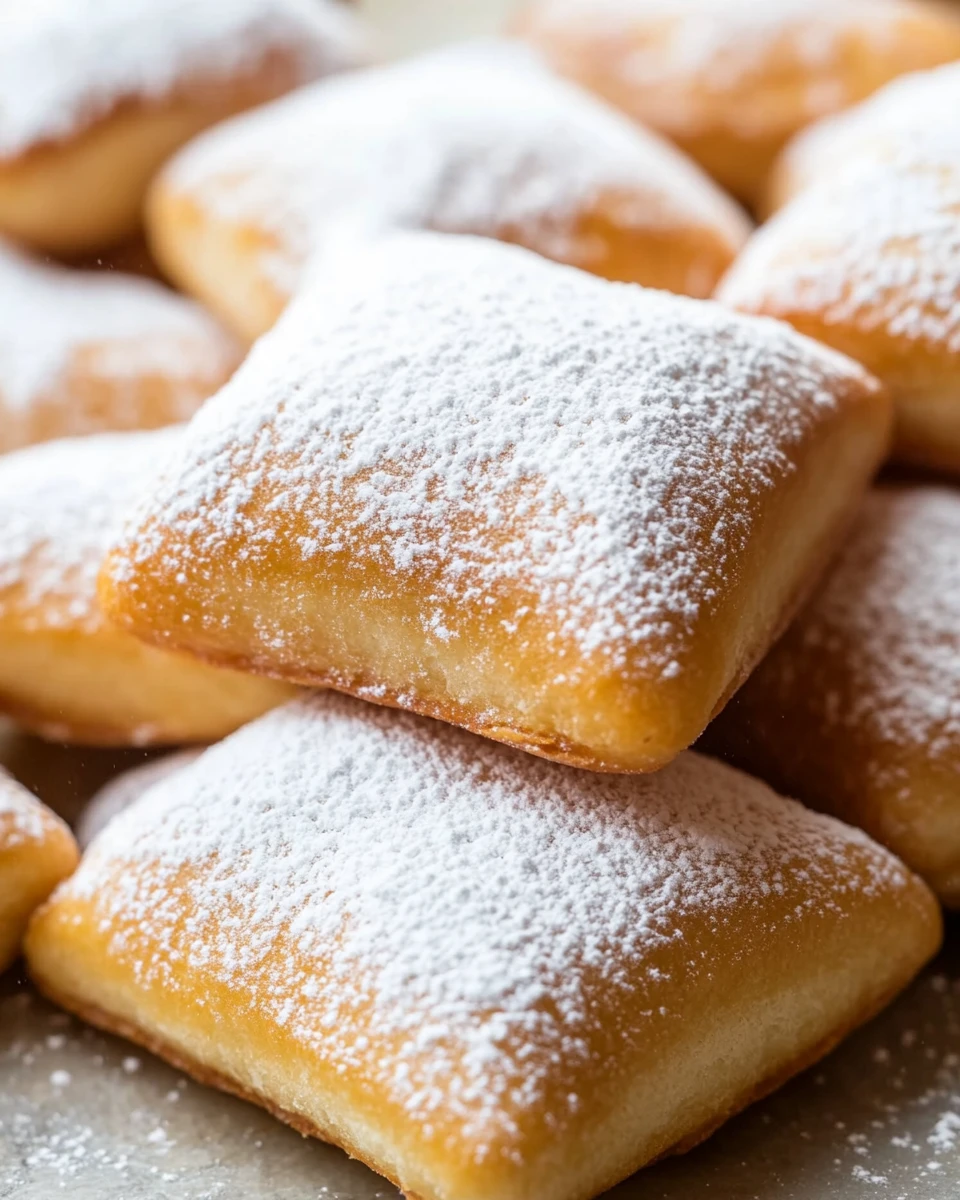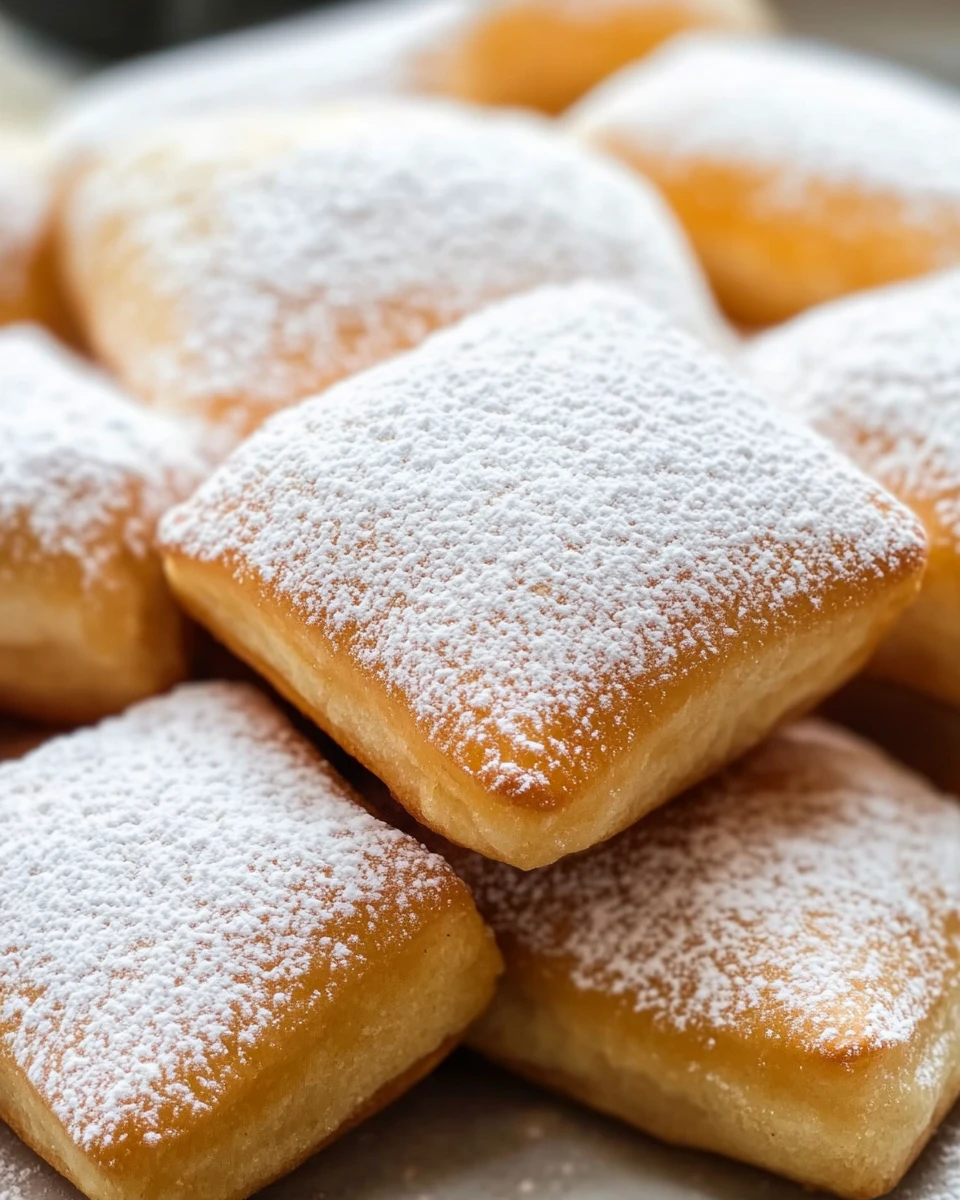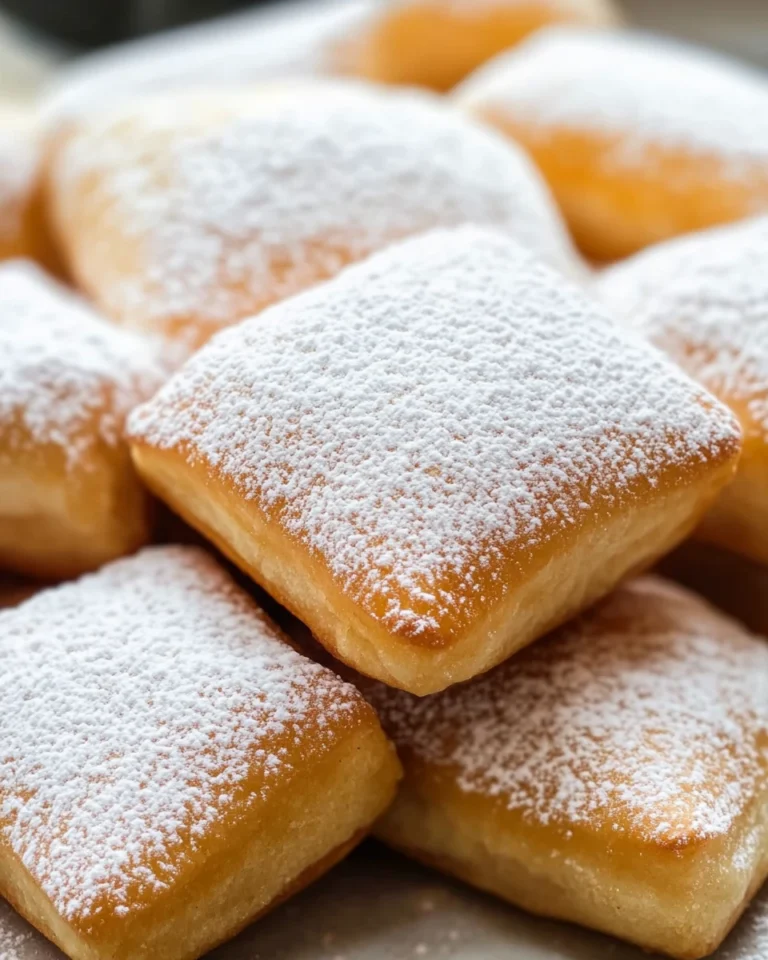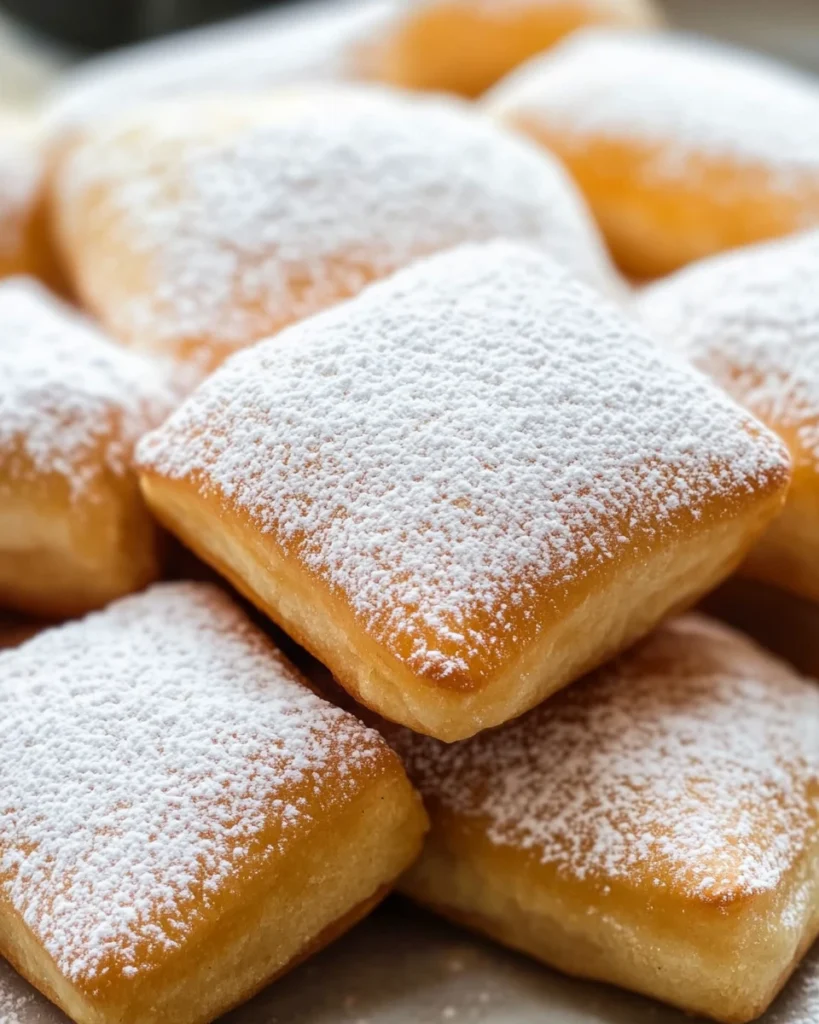The aroma of freshly made beignets can transport you straight to the lively streets of New Orleans. If you’ve ever wondered how to make beignets that are as soft and fluffy as the ones from a French Quarter café, you’re in the right place! Making these delightful pastries is easier than you might think and can be a great way to impress your friends and family. They are perfect for brunch or simply as a sweet treat to enjoy at any time of day. With every bite, you’ll be rewarded with a sugary, melt-in-your-mouth experience that feels like pure indulgence. So, let’s get started on this fun culinary adventure, and soon you’ll be savoring your very own batch of homemade beignets!
Jump to:
- Why This Recipe Works
- Why You’ll Love This How to make Beignets
- Ingredients for Beignets
- Preparing the Dough for Beignets
- Mix the Wet Ingredients and Dry Ingredients
- Knead and Let Rise
- Deflate and Second Rise
- Roll and Cut the Dough
- Frying Your Beignets
- Heat the Oil
- Fry the Beignets
- Drain and Dust with Sugar
- Serving Suggestions for Beignets
- Tips for Success
- Variations of Beignets
- FAQs
- More Easy Breakfast Recipes:
- 📖 Recipe Card
Why This Recipe Works
When making beignets, a few key techniques ensure the best results. First, by combining warm liquids—water and milk—you activate the yeast. This activation is crucial for achieving that light, fluffy texture we all crave. Next, the resting times let the dough develop not just flavor but also a wonderful texture. It builds up amazing layers that create that perfect bite. Lastly, frying at exactly the right temperature guarantees a crisp, golden exterior while keeping the inside airy and soft. It’s all about balance!
Why You’ll Love This How to make Beignets
Now, why will you fall in love with how to make beignets? First, they are just incredibly soft and fluffy when done right. You take a bite, and it feels like a warm hug from the inside out. That sugary dusting gives them a delightful touch, making them a melt-in-your-mouth experience. Beignets are also incredibly versatile, making them perfect for brunch or just a sweet snack anytime. You can easily adapt the flavors or fillings to your preferences. But most importantly, making fresh beignets is like bringing a little piece of New Orleans home, adding joy and sweetness to any occasion!

Ingredients for Beignets
Before you start, here’s what you’ll need:
– 1/2 cup lukewarm water
– 1/2 cup lukewarm milk
– 2 tablespoons unsalted butter, melted
– 1 large egg, at room temperature
– 1/4 cup granulated white sugar
– 1 teaspoon kosher salt
– 4 cups all-purpose flour
– 2 teaspoons instant yeast
– Canola oil (for frying)
– Powdered sugar (for dusting)
Preparing the Dough for Beignets

Mix the Wet Ingredients and Dry Ingredients
Start off by gathering your ingredients. In the bowl of a stand mixer fitted with the dough hook, pour in the lukewarm water and milk. Next, melt the butter and add that along with the egg, granulated sugar, and kosher salt. Then, add the flour and instant yeast. It’s a simple mix, but it brings everything together for a fluffy dough.
Knead and Let Rise
Turn on the mixer to low speed and knead the mixture until you have a soft, smooth dough. Once it’s combined nicely, cover your mixing bowl with a clean kitchen towel and let it rise for about 1 hour. Just wait until it puffs up beautifully.
Deflate and Second Rise
After the first rise, you’ll want to gently deflate the dough by punching it down. This step is important. Transfer the dough into a greased bowl and cover it with plastic wrap. This second rise can take about 2 to 3 hours. It might seem like a long time, but it’s worth it for the texture and flavor.
Roll and Cut the Dough
When the dough has become puffy again, turn it out onto a lightly floured work surface. Roll it into a rectangle measuring roughly 14×10 inches and about 1/2 inch thick. With a sharp knife or pizza cutter, cut the rolled dough into 2-inch squares. These will be the perfect shape for frying.
Frying Your Beignets
Heat the Oil
Now comes the fun part—frying! In a heavy-bottomed deep fryer or a Dutch oven, add canola oil and heat it over medium heat until it reaches about 375 degrees F. This temperature is key to making sure your beignets fry evenly.
Fry the Beignets
Carefully drop 5 or 6 squares of dough into the hot oil. You might notice them sink first; however, they will rise to the surface after about 5 seconds. Fry them for around 1 minute, and then flip them to fry for another minute. You want them lightly puffed and golden brown.
Drain and Dust with Sugar
Once cooked, use a slotted spoon to remove the beignets and let them drain on a paper towel-lined platter. After they’ve cooled a bit, it’s time for the final touch! Generously dust them with powdered sugar, giving them that iconic look.
Serving Suggestions for Beignets
Beignets are great on their own, but why not elevate your experience? Serve them alongside a nice cup of coffee or hot chocolate for an authentic café experience. You can even pair them with fresh fruit jams or creamy fillings to add a delightful twist.
Tips for Success
To make sure your beignets turn out perfect:
– Always ensure your liquids are lukewarm to properly activate the yeast.
– Avoid overcrowding your frying pot; this helps them cook evenly.
– Keep an eye on that oil temperature—it’s crucial for achieving puffiness!
Variations of Beignets
Feeling adventurous? Here are some fun twists on the classic beignet:
– Cinnamon Sugar Beignets: After frying, toss them in a mix of sugar and cinnamon for a delightful flavor.
– Stuffed Beignets: Try filling them with pastry cream or chocolate before frying for a sweet surprise.
– Savory Beignets: Incorporate herbs and cheese into the dough for an interesting savory option.
FAQs
1. Can I make beignet dough ahead of time?
Absolutely! You can refrigerate the dough for up to a week, and it often gets better with age.
2. What should I do if my dough isn’t rising?
Make sure your yeast is fresh and that your liquids are lukewarm to encourage proper activation.
3. Can beignets be frozen?
Yes! Roll out and cut the beignets before freezing. When you’re ready to enjoy them, you can fry them straight from the freezer.
4. What type of oil is best for frying beignets?
Canola oil is great! It has a high smoke point and a neutral flavor that works well.
5. How can I prevent my beignets from absorbing too much oil?
Ensure that your frying oil is hot enough to create a nice outer seal quickly, which helps reduce oil absorption.
Making homemade beignets is a joyous experience. They can bring warmth and happiness to any gathering. With the right mix of techniques, patience, and a bit of love, you can replicate those classic flavors in your own kitchen. Enjoy the process, and savor every delightful bite!
More Easy Breakfast Recipes:
Did You Enjoy Making This Recipe? Please rate this recipe with ⭐⭐⭐⭐⭐ or leave a comment.
📖 Recipe Card
Print
Beignets
These beignets are the perfect blend of softness and sweetness, making them a delightful treat for brunch or an afternoon snack. With their sugary coating and airy interior, each bite offers a taste of New Orleans magic right at home.
- Total Time: 2 hours 10 minutes
- Yield: Approximately 24 beignets 1x
Ingredients
- 1/2 cup lukewarm water
- 1/2 cup lukewarm milk
- 2 tablespoons unsalted butter, melted
- 1 large egg, at room temperature
- 1/4 cup granulated white sugar
- 1 teaspoon kosher salt
- 4 cups all-purpose flour
- 2 teaspoons instant yeast
- Canola oil (for frying)
- Powdered sugar (for dusting)
Instructions
- Mix the lukewarm water, milk, melted butter, egg, sugar, and salt in a stand mixer.
- Add flour and yeast, and knead until smooth.
- Cover and let rise for 1 hour.
- Deflate the dough and let it rise again for 2-3 hours.
- Roll the dough into a rectangle and cut into 2-inch squares.
- Heat oil to 375°F and fry the squares in batches until golden brown.
- Drain on paper towels and dust with powdered sugar.
Notes
Ensure liquids are lukewarm to activate the yeast properly.
Do not overcrowd the frying pot for even cooking.
Monitor the oil temperature for perfect puffiness.
- Prep Time: 2 hours
- Cook Time: 10 minutes
- Category: Dessert
- Method: Frying
- Cuisine: French
Nutrition
- Calories: 220
- Sugar: 5g
- Sodium: 210mg
- Fat: 10g
- Saturated Fat: 3g
- Unsaturated Fat: 7g
- Trans Fat: 0g
- Carbohydrates: 30g
- Fiber: 1g
- Protein: 3g
- Cholesterol: 25mg







